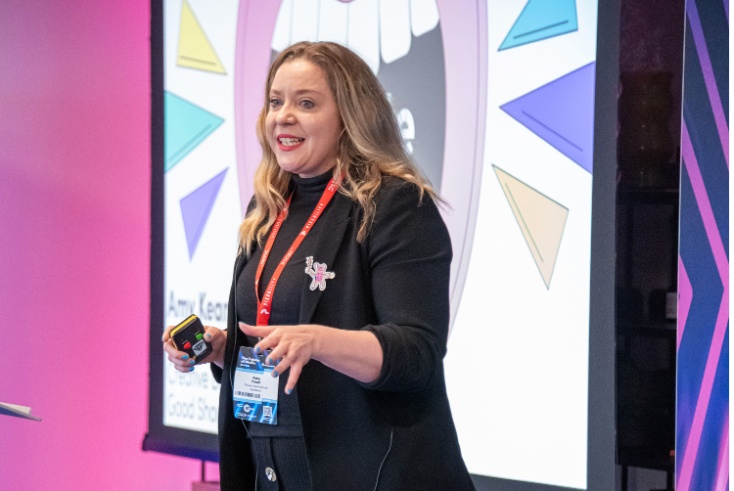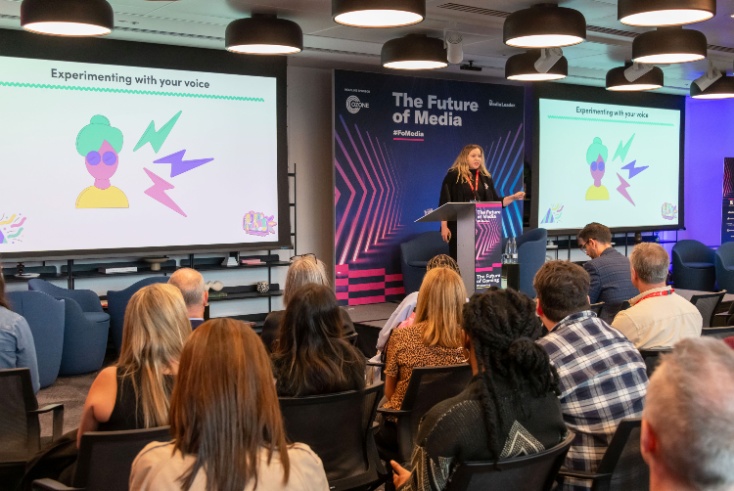Future media leaders warned: Don’t take your ‘voice’ for granted

The Future of Media
You only have seven seconds to make a good first impression at work.
That was one of a number of insights delivered by Amy Kean, CEO and creative director of Good Shout, who addressed The Media Leader’s Future100 club at The Future of Media earlier this month.
“Every single person in this room genuinely has a responsibility to use your voice in a way that has meaning and to use your voice in a way that adds value. But that’s a lot of work,” she warned in a talk explaining why people are not using their voices and how to change this.
Kean said that we were living in a world where everyone is starting to talk and act the same, and use the same mannerisms, using typical “TED Talk speak” as an example, and also because we spend all the time talking it has “made us really mindless with our voices”.
Around this topic, she said using jargon was “a sign of insecurity” or “a comfort blanket that doesn’t mean anything”, which we use “to survive socially” but have to try to avoid.
Kean also cited a study which found that everyone has seven seconds in a first impression scenario for people to make 11 different judgments about us based on body language, aesthetics, but primarily voice and accent.

“Our voices are huge. Our voices are so significant. Our voices are complicated. Our voices are social. Our voices are the outcome of our experience, our backgrounds, our coaches. Our voices are interwoven with our emotions and our trauma occasionally. Our voices are these powerful, fragile things that most people take for granted,” Kean stated.
She made the case for discipline when using your voice, explaining you could be “the most interesting, confident person ever”, but if you do not have the discipline, then you are “just adding noise to an already very noisy world”.
Kean offered four tips to get people’s voices out there and make them “really strong”.
Know yourself
Kean uses a “three T” framework to help recognising your voice’s own originality; your tone, your thing and your temerity.
Every single person should have a different tone and this can be found by asking what three words would you like someone to think of when they think of you.
Thing could be a particular issue you are passionate about like mental health or sport, and temerity relates to your self-belief or “cockiness”.
Know your USP
This refers to “unique standout performance” rather than “unique selling point”.
She said that understanding what “you at your best” looks like, which again should be different for everyone, be that chaotic, pensive, challenging, provocative.
Know your limit
This related to acknowledging who you are happy to “wind up” or “disagree with” when making changing with your voice.
Kean commented: “You do have a voice and you want to add value, but how much value do you want to add? Because if you really want to make some change with your voice, you’re going to piss some people off and I say this confidently, because I do.”
She also recommended everyone look in to “the perceived weird index” to figure out the “perfect type of person who is literally able to drive change either in an industry or within an organisation”.
The sweet spot is to be weird enough so that you stand out and not “get sucked into the cultural conditioning”, which she said as an industry media was “very hot on”. However, you also have to be normal enough that people trust you and buy into what you say.
Know your point
So often for many people in meetings, panels, presentations or interviews they do not have what they have to say to answer a question fully prepared, Keane says.
She advises a “three P” framework for this of punch, proof and progress.
On “punch”, to make an impact with your voice, you will need assertive statements and soundbites. On the second, Kean implored delegates to “for God’s sake have substance and insight”. And finally on progress, she advised sharing the new thing that adds value to the industry.
You can watch the full session below.



